by: Lewin Day February 5, 2020
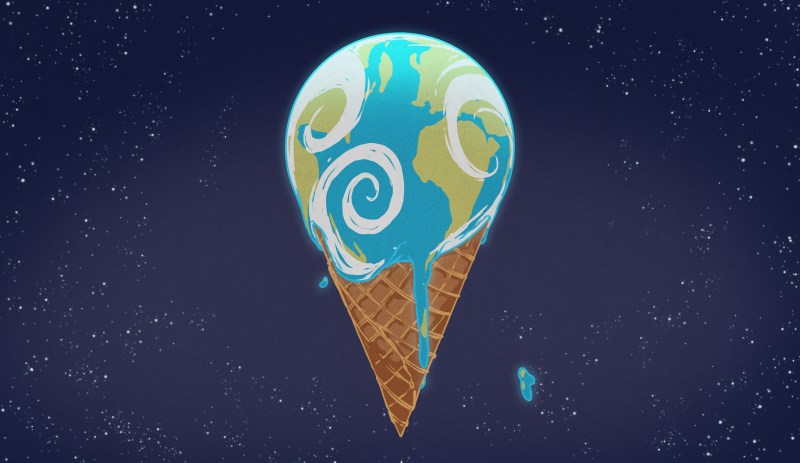
With global temperatures continuing to break records in recent years, it’s important to cast an eye towards the future. While efforts to reduce emissions remain in a political quagmire, time is running out to arrest the slide into catastrophe.
Further compounding the issue are a variety of positive feedback loops that promise to further compound the problem. In these cases, initial warming has flow-on effects that then serve to further increase global temperatures. Avoiding these feedback mechanisms is crucial if the Earth is to remain comfortably livable out to the end of the century.
A MULTITUDE OF CAUSES
The issue of climate change often appears as a simple one, with the goal being to reduce greenhouse gas emissions in order to prevent negative consequences for human civilization. Despite this, the effects of climate change are often diffuse and intermingled. The various climate systems of the Earth interact in incredibly complex ways, and there are many mechanisms at play in these feedback effects that could tip things over the edge.
ICE-ALBEDO
The issue of climate change often appears as a simple one, with the goal being to reduce greenhouse gas emissions in order to prevent negative consequences for human civilization. Despite this, the effects of climate change are often diffuse and intermingled. The various climate systems of the Earth interact in incredibly complex ways, and there are many mechanisms at play in these feedback effects that could tip things over the edge.
ICE-ALBEDO
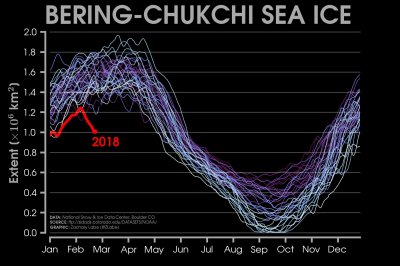
A graph showing the sudden drop in Bering-Chukchi sea ice seen in 2018. This kind of abrupt change is not currently accounted for in climate models.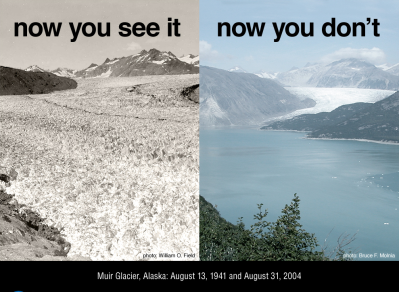

NASA photographs showing the loss of ice at the Muir Glacier in Alaska, from 1941 and 2004.
The ice-albedo feedback mechanism is a climate process in which the amount of ice on earth has a significant effect on global temperature changes. It’s a positive feedback relationship, meaning it has the possibility of causing a runaway effect if not managed carefully. Higher global temperatures cause sea ice, land ice, and glaciers to melt. The ice, which is highly reflective, is instead replaced with open water, or land, which is less reflective, having a lower albedo. This causes the Earth to retain more heat from solar radiation, instead of reflecting it back into space. This further raises temperatures, causing more ice to melt, creating the positive feedback effect.
Ice levels around the world are an active target of study for climate scientists. Records show major sustained losses over recent decades to major ice sheets, and glaciers are retreating all over the world. These areas, formerly covered in highly reflective ice, are now absorbing more heat than ever from solar radiation. As temperatures continue to rise, it’s likely that ice packs around the world will continue to thaw, further exacerbating the effect.
METHANE RELEASES FROM NOT-SO-PERMAFROST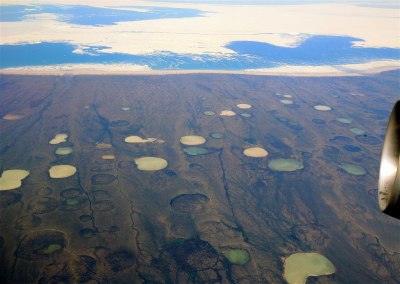
The ice-albedo feedback mechanism is a climate process in which the amount of ice on earth has a significant effect on global temperature changes. It’s a positive feedback relationship, meaning it has the possibility of causing a runaway effect if not managed carefully. Higher global temperatures cause sea ice, land ice, and glaciers to melt. The ice, which is highly reflective, is instead replaced with open water, or land, which is less reflective, having a lower albedo. This causes the Earth to retain more heat from solar radiation, instead of reflecting it back into space. This further raises temperatures, causing more ice to melt, creating the positive feedback effect.
Ice levels around the world are an active target of study for climate scientists. Records show major sustained losses over recent decades to major ice sheets, and glaciers are retreating all over the world. These areas, formerly covered in highly reflective ice, are now absorbing more heat than ever from solar radiation. As temperatures continue to rise, it’s likely that ice packs around the world will continue to thaw, further exacerbating the effect.
METHANE RELEASES FROM NOT-SO-PERMAFROST

Melting permafrost in Canada in 2008. Photo credit: Steve Jurvetson
Another major concern of climate scientists is the possibility of large-scale releases of methane and other greenhouse gases into the atmosphere from a variety of environmental sources. Areas such as Western Siberia have large reserves of methane trapped under permafrost, while significant reserves exist under the oceans, too. As the climate warms, much of this permafrost is beginning to thaw, releasing the stored methane trapped below the surface. This has the effect of further increasing warming, as methane is a potent greenhouse gas, with a warming potential over 20 times that of CO2 over a 20 year time frame.
There is significant worry that a tipping point could be reached in which there is an abrupt release of large amounts of methane from these sources, causing a rapid increase in global temperatures. In this event, reducing human emissions would do little to help, as the released greenhouse gases can not simply be returned to the soil. Research is ongoing to produce models to predict what will happen in the event of further thawing of formerly-permanent permafrost. There is some hope — slower thawing seems likely to reduce the amount of harmful greenhouse gases released, as plants grow in formerly frozen areas, once again locking up carbon. Faster thaws threaten more massive, abrupt releases, which are more likely to result in rapid temperature rise.
Another major concern of climate scientists is the possibility of large-scale releases of methane and other greenhouse gases into the atmosphere from a variety of environmental sources. Areas such as Western Siberia have large reserves of methane trapped under permafrost, while significant reserves exist under the oceans, too. As the climate warms, much of this permafrost is beginning to thaw, releasing the stored methane trapped below the surface. This has the effect of further increasing warming, as methane is a potent greenhouse gas, with a warming potential over 20 times that of CO2 over a 20 year time frame.
There is significant worry that a tipping point could be reached in which there is an abrupt release of large amounts of methane from these sources, causing a rapid increase in global temperatures. In this event, reducing human emissions would do little to help, as the released greenhouse gases can not simply be returned to the soil. Research is ongoing to produce models to predict what will happen in the event of further thawing of formerly-permanent permafrost. There is some hope — slower thawing seems likely to reduce the amount of harmful greenhouse gases released, as plants grow in formerly frozen areas, once again locking up carbon. Faster thaws threaten more massive, abrupt releases, which are more likely to result in rapid temperature rise.
OCEAN CURRENT SLOWDOWN
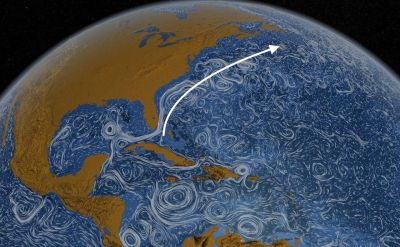
Ocean currents have a big role to play in the climate. Photo credit; NASA
The world’s oceans are a major player in the climate system. Acting as a giant heat sink, what happens in the oceans tends to have staggering effects on weather patterns everywhere. Major ocean currents are a large part of this mechanism, responsible for transporting huge amounts of heat stored in these waters around the globe.
Scientists have been monitoring changes in ocean currents, and have observed major changes in recent years. The Gulf Stream is one such current, which has often been linked to major climate events in the distant past. It’s slowing down, and is currently weaker than at any point in the last 1600 years. The weakening is unprecedented, and current research suggests the change is at least in part due to human-induced climate change. The effect is multifaceted, with temperature increases and freshwater from melting sea ice both playing a role.
Many theorize that a slowdown or shutdown of ocean currents could have major consequences on the world climate. Extreme warming or cooling could occur in different areas, and storm activity, such as hurricanes, could increase in both frequency and magnitude. Research suggests that changes in these currents can be both an indicator and driver of climate shifts, and it’s likely that ocean currents will continue to change as anthropogenic warming continues.
FOREST LOSS AND FIRES
The world’s oceans are a major player in the climate system. Acting as a giant heat sink, what happens in the oceans tends to have staggering effects on weather patterns everywhere. Major ocean currents are a large part of this mechanism, responsible for transporting huge amounts of heat stored in these waters around the globe.
Scientists have been monitoring changes in ocean currents, and have observed major changes in recent years. The Gulf Stream is one such current, which has often been linked to major climate events in the distant past. It’s slowing down, and is currently weaker than at any point in the last 1600 years. The weakening is unprecedented, and current research suggests the change is at least in part due to human-induced climate change. The effect is multifaceted, with temperature increases and freshwater from melting sea ice both playing a role.
Many theorize that a slowdown or shutdown of ocean currents could have major consequences on the world climate. Extreme warming or cooling could occur in different areas, and storm activity, such as hurricanes, could increase in both frequency and magnitude. Research suggests that changes in these currents can be both an indicator and driver of climate shifts, and it’s likely that ocean currents will continue to change as anthropogenic warming continues.
FOREST LOSS AND FIRES

Smoke from bushfires in Eastern Australia, as seen from satellite imagery. The 2019/2020 fire season has been unprecedented in ferocity.
Forests are an important player in the global climate, acting as a major carbon dioxide sink. However, in recent years, increased temperatures and extreme wildfires have led to large swathes of forests dying off or simply going up in smoke. As trees die and are broken down by microbes, or as they burn up in fires, this leads to releases of greenhouse gases. This causes further warming, compounding the problem in yet another example of positive feedback.
Wildfires are becoming worse and more frequent. Last year’s Arctic wildfires released a massive volume of CO2 in June alone — equal to Sweden’s annual total output. After facing its hottest and driest year on record in 2019, Australia also faced its worst recorded fire season, with over 10 million hectares burned. These fires grew large enough to create their own weather, with Pyrocumulonimbus clouds observed forming from the smoke and causing lightning storms which spawned further fires in other areas. This is a case of positive feedback in the very short term, with large fires creating further fires due to the harsh conditions.
Forest die-offs have their own consequences, too. Boreal forests are shrinking, thus acting as less of a carbon sink as tree numbers begin to dwindle. As the forests thin out, conditions get warmer and dryer for remaining trees, further accelerating the decline. This also leads to issues as other species, both flora and fauna, have to adapt as tree cover shrinks and conditions change.
Forests are an important player in the global climate, acting as a major carbon dioxide sink. However, in recent years, increased temperatures and extreme wildfires have led to large swathes of forests dying off or simply going up in smoke. As trees die and are broken down by microbes, or as they burn up in fires, this leads to releases of greenhouse gases. This causes further warming, compounding the problem in yet another example of positive feedback.
Wildfires are becoming worse and more frequent. Last year’s Arctic wildfires released a massive volume of CO2 in June alone — equal to Sweden’s annual total output. After facing its hottest and driest year on record in 2019, Australia also faced its worst recorded fire season, with over 10 million hectares burned. These fires grew large enough to create their own weather, with Pyrocumulonimbus clouds observed forming from the smoke and causing lightning storms which spawned further fires in other areas. This is a case of positive feedback in the very short term, with large fires creating further fires due to the harsh conditions.
Forest die-offs have their own consequences, too. Boreal forests are shrinking, thus acting as less of a carbon sink as tree numbers begin to dwindle. As the forests thin out, conditions get warmer and dryer for remaining trees, further accelerating the decline. This also leads to issues as other species, both flora and fauna, have to adapt as tree cover shrinks and conditions change.
WHAT CAN BE DONE?
The aforementioned feedback mechanisms are all current areas of research for climate scientists around the globe. The topic of abrupt and sudden climate change is only loosely understood. Most existing climate models are based on steady, gradual changes to the climate from human activity. These models don’t account for the possibility of large sudden methane releases from formerly frozen soils, or mass releases of carbon dioxide from continental-scale wildfires.
Unfortunately, the mechanisms at play in these feedback scenarios are far beyond the scale that humanity can realistically arrest. The only real mechanism with which to play with is the output of greenhouse gases from human activities. By reigning in emissions, there is a possibility that humanity still has time to avoid triggering these tipping points. Only time will tell.
---30---
No comments:
Post a Comment